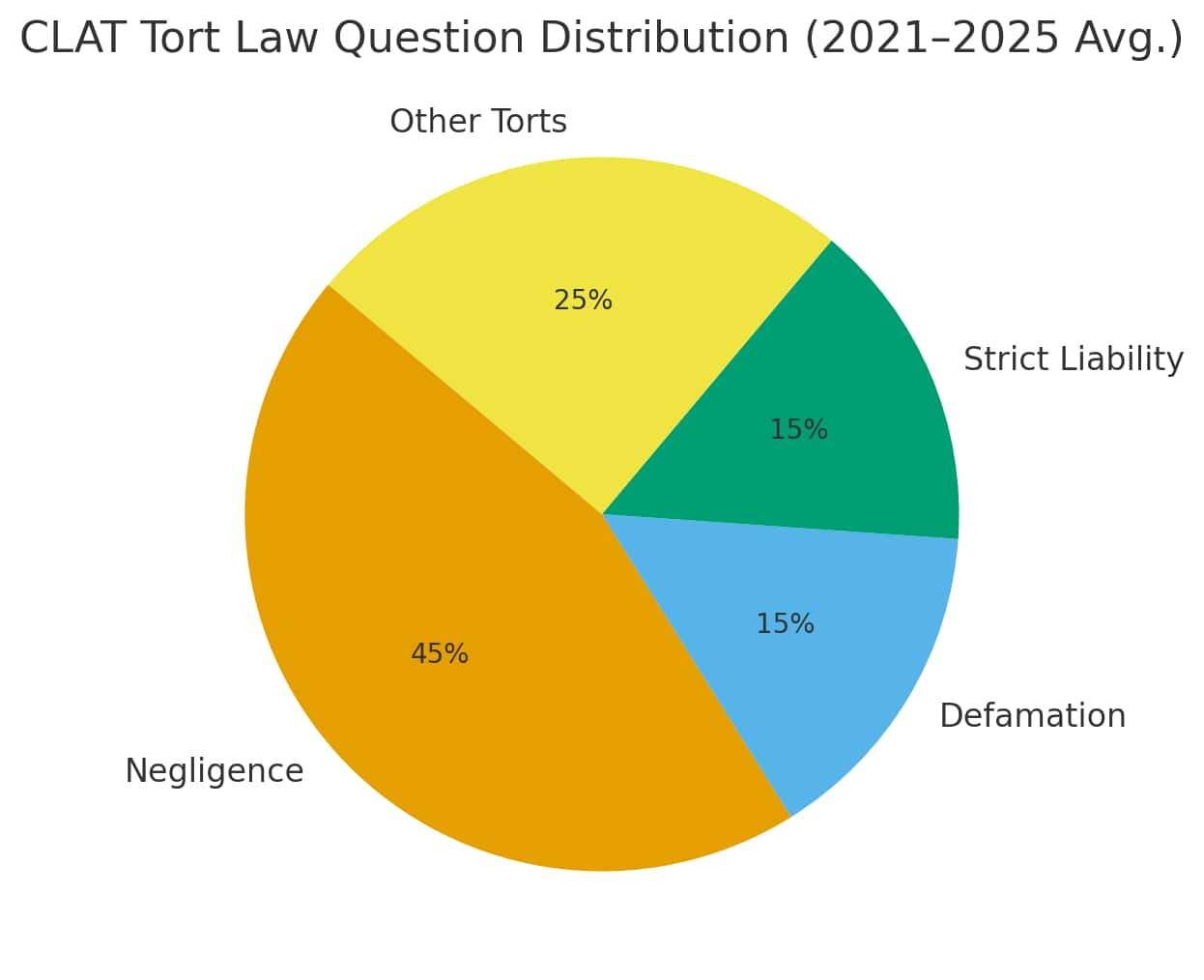UPES Integrated LLB Admissions 2026
Ranked #18 amongst Institutions in India by NIRF | Ranked #1 in India for Academic Reputation by QS Rankings | 16 LPA Highest CTC
CLAT Exam Date:07 Dec' 25 - 07 Dec' 25
Did you know that the majority of CLAT 2026 Tort Law Questions revolve around just a handful of principles? While the Tort Law is vast, analysis of CLAT Previous Year Papers (2021-2025) shows that three principles alone cover nearly 70% of the questions. This means that by strategically focusing on these, you can secure most of your CLAT 2026 torts score without drawing in unnecessary detail.

In this article, we’ll break down these three principles, their weightage, and provide you with smart preparation strategies, along with CLAT 2026 MCQs practice questions.
The CLAT 2026 Legal Reasoning is also a very integral part of the syllabus. This subject too has weightage in the entire exam. Roughly, there will be around 32 questions from CLAT 2026 Legal Reasoning. In the past few years, Tort Law has been a topic that has been repeated every time. There are around one or two passages each year from Tort Law. The table below throws light on the CLAT Tort Law Questions in previous (2021-2025) years and expected topics for the upcoming session.
Year | Total Tort Questions | Negligence Questions | Defamation Questions | Strict Liability Questions | Other Principles Questions | Percentage Weightage |
2021 | 6Q | 2 | 1 | - | 3 | 33% Negligence |
2022 | 5Q | 1 | 2 | - | 2 | 34% Defamation |
2023 | 7Q | 1 | - | 1 | 5 | 15% Trespass |
2024 | 4Q | - | - | 1 | 3 | 18% Vicarious Liability |
2025 | 5Q | 2 | - | 2 | 1 | 35% Strict Liability |
Here’s a structured breakdown of how just three core tort law principles—Negligence, Defamation, and Strict Liability—cover nearly 70% of CLAT tort questions (2021–2025):
Significance: Negligence is one of the most frequently tested principles in tort law. It revolves around the breach of a duty of care that results in harm to another person.
Why it's important: It applies to a wide range of scenarios, from accidents to medical malpractice, making it a fundamental principle for CLAT exams.
Aspect | Details |
Weightage | ~23% (2021–2025) |
Definition | Breach of a duty of care resulting in harm |
Example | A doctor leaves a surgical tool in a patient’s body. |
Exam Relevance | Frequently tested in real-life accident or malpractice scenarios. |
Significance: Defamation law is often tested in questions related to damage to reputation through false statements. It covers both slander and libel.
Why it's important: Defamation cases often appear in the context of freedom of speech, making it crucial for understanding the balance between reputation and expression.
Aspect | Details |
Weightage | ~22% (2021–2025) |
Definition | False statement damaging someone’s reputation (slander/libel). |
Example | A newspaper falsely claims a politician is corrupt. |
Exam Relevance | Balances freedom of speech vs the right to reputation. Common in media-related passages. |
Significance: Strict liability involves holding a defendant liable for harm caused by their actions, even if there was no intention to harm or negligence involved.
Why it's important: It applies to dangerous activities, such as using hazardous materials or keeping wild animals, and is commonly tested in multiple-choice scenarios.
Aspect | Details |
Weightage | ~25% (2021–2025) |
Definition | Liability for harm even without fault or negligence. |
Example | A toxic gas leak occurs despite the owner’s precautions. |
Exam Relevance | Frequently tested with hazardous substances, industries, or wild animals. |

While Negligence, Defamation, and Strict Liability dominate, CLAT occasionally includes 1–2 questions from other tort principles. These appear irregularly but are still worth a quick review.
Principle | Frequency (2021–2025) | Weightage | Example Scenario | Exam Appearance |
Nuisance | 1/5 years | <10% | Factory noise affecting neighbours | Rare |
Vicarious Liability | 1/5 years | ~12% | The employer is liable for the employee’s negligence | Infrequent |
Trespass | 1/5 years | ~8% | Unauthorised entry into land | Rare |
Based on an analysis of previous CLAT papers, it's evident that three core principles in Tort Law cover nearly 70% of the questions asked. These principles are Negligence, Defamation, and Strict Liability. To help you focus your preparation, we have compiled MCQs to practice these high-weightage topics and additional topics. These will help you solidify your knowledge and prepare effectively for the CLAT 2026.
You may also check,
Focusing on Negligence, Defamation, and Strict Liability, which accounted for 70% of the CLAT Tort Questions in the past 5 years, is statistically the most efficient strategy.
Prioritise Past Year Papers
Solve all CLAT papers from 2021 and 2025.
Highlight tort questions and identify which principle they relate to.
You’ll notice the dominance of Negligence, Defamation, and Strict Liability.
A balanced study schedule should include taking CLAT mock tests, reviewing material, and learning new topics.
Practice Fact-Based Scenarios
CLAT doesn’t test definitions—it tests application.
Principle | Example Scenario | Exam Relevance |
Negligence | A doctor leaving a surgical tool in a patient | Most common in real-life accidents |
Defamation | False claim about a politician | Media-related cases |
Strict Liability | Factory leak due to negligence | Common in hazardous activities |
Revision Tips
Make concise, one-page notes for each principle.
Create a question bank with 20+ fact-based examples for each premise.
Revise 1-2 times before the exam week to improve memory speed.
For information on how to effectively manage your time and study, please refer to the CLAT Time Management article.
On Question asked by student community
Hello
The best way to cover the important current affairs is to read the newspaper daily. Then try to analyse the newspaper and remember the trending topics. Practice the previous year's question paper and understand the pattern of the question. Summarise all current affairs topics and understand them in brief. If you want more information about current affairs, then you will read the article How to Prepare for CLAT Current Affairs 2026 .
Thank you.
Hello,
Yes, you can prepare CLAT (Common Law Admission Test) in Hindi Medium and access syllabus in Hindi from mentioned link below:
https://law.careers360.com/hi/articles/clat-syllabus
Hope it helps.
Hello there!
Joint Entrance Exam (JEE) is a national level entrance exam for the programs related to engineering. It has two levels known as JEE mains (first level) and JEE advance (second level) . Many colleges from all over India in both government and private sector consider its scores. It is an online computer based test conducted by NTA ( National Testing Agency). Physics , Chemistry and mathematics are the major subjects to be focused in this exam.
Here is the link attached from the official website of Careers360 which will provide you with complete information about JEE.
https://engineering.careers360.com/exams/jee-main
NEET ( National Eligibility cum Entrance Test) is a national level examination for admission in undergraduate medical courses. It is also conducted by NTA but in offline mode as in pen and paper test. It includes courses like MBBS, BDS BHMS , BAMS etc. The exam consists of 180 questions in total 45 from each physics , chemistry , zoology and Botany. The total marks for the exam are 720 marks.
Here is the link attached from the official website of Careers360 which will provide you with complete information about NEET examination:
https://medicine.careers360.com/articles/neet-full-form
CLAT (Common Law Admission Test) is a national level entrance examination for the admission in national law colleges of India. The test is taken after 12th grade examination for the 5 years integrated programs in law. It tests students knowledge in legal aptitude. It also serves as a basis for public sector undertakings for legal positions.
Here is the link attached from the official website of Careers360 which will provide you with the complete information about the CLAT examination.
https://law.careers360.com/articles/what-is-clat-full-form-all-about-nlus-entrance-exam
thank you! Hope it helps!
Hello,
The CLAT PG exam pattern consists of 120 questions and 2-hour MCQ exam with negative marking.
Subjects Covered:
Constitutional Law
Jurisprudence
Criminal Law
Contract Law
Other core law subjects
Here are some tricks which you must follow:
To know more access below mentioned link:
https://law.careers360.com/articles/how-to-prepare-for-clat-pg-exam
Hope it helps.
Hello,
In CLAT , the 9-digit admit card number is not the same as the roll number you have to write on the OMR sheet. The OMR sheet has only 7 blocks because the CLAT roll number is shorter.
You should check your admit card again and look for the roll number printed near your name and exam details. Fill only that roll number in the OMR sheet. Do not write the 9-digit admit card number.
If you still cannot find the roll number, you can ask the exam invigilator on the exam day.
Hope it helps !
Integrated Learning – A balanced blend of management and legal education
Among top 100 Universities Globally in the Times Higher Education (THE) Interdisciplinary Science Rankings 2026
Ranked #18 amongst Institutions in India by NIRF | Ranked #1 in India for Academic Reputation by QS Rankings | 16 LPA Highest CTC
Admissions open for B.A. LL.B. (Hons.), B.B.A. LL.B. (Hons.) and LL.B Program (3 Years) | School of Law, MRU ranked No. 1 in Law Schools of Excellence in India by GHRDC (2023)
Grade 'A+' accredited by NAAC | Ranked 33rd by NIRF 2025
Approved by BCI | Continuous interaction with leading experts from the industry | Global Exposure